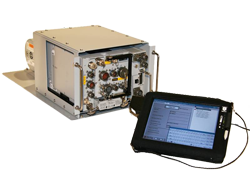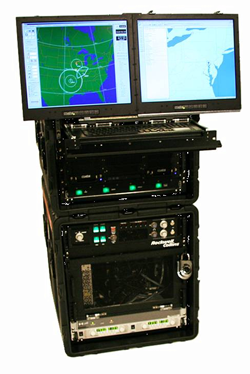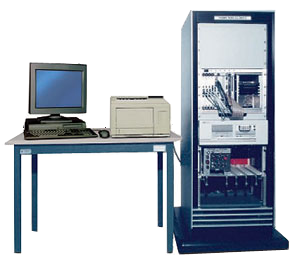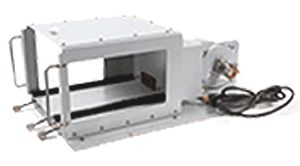

Support Equipment
DLS offers a number of accessories
that will assist in troubleshooting, testing, integrating,
installing, and maintaining your MIDS terminal. The links (at
left) will provide an introduction to specific DLS Support
Equipment available.
Key
areas of support equipment include:
Flight
Line/Forward Area Support Equipment
Intermediate
Level Support Equipment
Interface
Simulator Support Equipment
Power and Cooling
Custom Cable
Sets
Diagnostic and Simulation Software Packages
§

The Multifunction Integrated Test System (MITS) is
the latest addition to our DLS Link 16 Support
Equipment product line.
This system utilizes the latest generation
ruggedized tablet computer with colored flat screen
monitor - allowing the user to verify operational
terminal status on or off the aircraft.
The pen based tablet computer is easily hand held
(9 x 12.5 x 3, 5 lbs) and is ruggedized for
flight line operation. Operating temperature range
is -40˚ C to +70˚ C and the computer is sealed
against rain and dust.

Multifunction Integrated Test System
Features include:
Terminal Software Loader/Verifier
Network File Loader
Terminal Control/Monitor/Diagnostics
BIT Analysis
Windows XP on Tablet computer
Loads/Verifies core, I/O and MSG software
Provides two levels of status displays
Exercises Built-In-Test and interprets
results for field maintainers
Accesses MIDS diagnostic data for
troubleshooting in back-shop
Can read and write terminal data per the
Air Force specified standard format
Interfaces with support ports
SSPK is hosted in users laptop PC, where
other Link-16 software tools may exist
User-friendly graphical interface with
self-contained help
Intermediate Level Support Equipment <<Back to Top
The recently introduced Mobile Integration & Test Environment (MITE) system can provide a Line Replacement Unit (LRU) test capability with fault isolation to the Shop Replacement Unit (SRU) module. MITE identifies the faulty SRU which is then replaced and returned to the Depot for repair. The terminal LRU is then retested under a Repair Verification Test Procedure ensuring that the terminal is ready for service.

Mobile Integration & Test Environment (MITE)
system
Two Person Lift
19" Rack Enclosures
Displays: Dual 17" SXGA
In addition to the return-to-service capability, the MITE can provide:
-
Real time Terminal status and performance monitoring
-
Terminal initialization and control
-
Visibility into Terminal operation via the 1553 bus
or Support Port -
BIT initiation and monitoring
-
Access to software maintenance parameters
-
Reprogramming of Terminal Software Programs
(maintenance updates) -
Rapid data recording for post-test analysis
-
Enhanced troubleshooting
-
Recording and analysis of Terminal data
-
Situational display and scenario generation
-
Transmit and receive of TADIL-J messages
-
Windows-based user interface
Multifunctional Information Distribution System (MIDS) Interface Simulator (IS)

Multifunctional Information Distribution
System
(MIDS) Interface Simulator (IS)
-
The MIDS interface simulator (MIS) is the primary integration tool used by European platform integrators. It is a mature design with more than thirty systems deployed.
-
The MIS is capable of generating and evaluating scenarios in either of two operational modes.
-
In terminal simulation mode, the MIS controls the operational flight program hosted on commercial off-the-shelf (COTS) hardware. The MIS may also host these programs on MIDS SRUs (flight hardware).
-
In network simulation mode, the commercial hardware operates as a host platform while providing for the mounting, cooling and power provisions of a MIDS terminal.
-
Whatever mode of operation is selected, the testing effort will be maximized as a result of the integration of the MIS and the operational flight hardware and software.
§Power and Cooling <<Back to Top
This ensures accurate alignment of the cooling tray airflow ports to the airflow inlets on the MIDS and RPS. Front hold downs are provided to secure the units; two for the MIDS and one for the RPS.
|
Height 9.74
24.74 cm
Width 13.82
35.10 cm
Depth 25.00
63.50 cm
Weight (approx.) 20 lbs
(excluding MIDS LVT and RPS)
25 lbs (w/ 19 rack mount
adapter plate)
Electrical input 115/120
VAC
50/60 Hz
Power 50/60 Hz
230/240 VAC 50/60 Hz
50/60 Hz
Available Customer
Support / Warranty Provided
|
|
This unit is rack mountable in a standard 19 wide rack configuration. Adapter plates can be provided to meet existing mounting patterns. The cooling tray unit is designed to operate when supplied with 115/120 VAC 60 Hz power (standard U.S. operation). A second version of the cooling tray will operate when supplied with 230/240 VAC 50 Hz power (European/Asian operation).
Terms of Access | Privacy Statement
